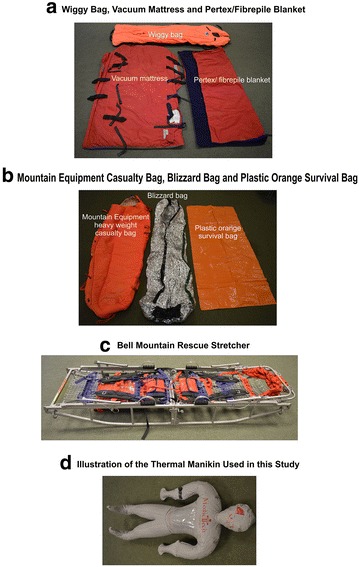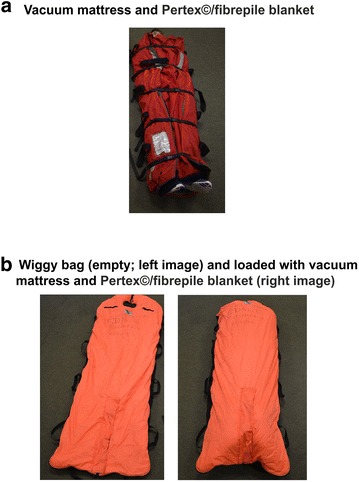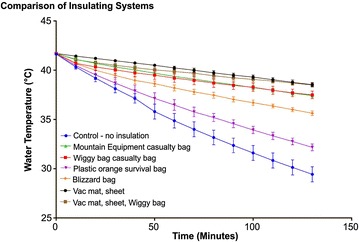下载PDF
{"title":"用不同的山地救援伤员袋保温的人体模型的冷却速率测量。","authors":"Christopher Press, Christopher Duffy, Jonathan Williams, Ben Cooper, Neil Chapman","doi":"10.1186/s13728-017-0055-7","DOIUrl":null,"url":null,"abstract":"<p><strong>Background: </strong>Accidental hypothermia is common in those who sustain injuries in remote environments. This is unpleasant and associated with adverse effects on subsequent patient outcomes. To minimise further heat loss, a range of insulating systems are available to mountain rescue teams although the most effective and cost-efficient have yet to be determined.</p><p><strong>Methods: </strong>Under ambient, still, dry, air conditions, a thermal manikin was filled with water at a temperature of 42 °C and then placed into a given insulation system. Water temperature was then continuously observed via an in-dwelling temperature sensor linked to a PROPAQ 100 series monitor and recorded every 10 min for 130 min. This method was repeated for each insulating package.</p><p><strong>Results: </strong>The vacuum mattress/Pertex©/fibrepile blanket system, either on its own or coupled with the Wiggy bag, was the most efficient with water temperatures only decreasing by 3.2 °C over 130 min. This was followed by the heavy-weight casualty bags without the vacuum mattress/Pertex©/fibrepile blanket system, decreasing by 4.2-4.3 °C. With the Blizzard bag, a decline in water temperature of 5.4 °C was seen over the study duration while a decrease of 9.5 °C was noted when the plastic survival bag was employed.</p><p><strong>Conclusions: </strong>Under the still-air conditions of the study, the vacuum mattress/Pertex©/fibrepile blanket was seen to offer comparable insulation effectiveness compared to be both heavy-weight casualty bags. In turn, these three systems appeared more efficient at insulating the manikin than the Blizzard bag or plastic survival bag.</p>","PeriodicalId":89765,"journal":{"name":"Extreme physiology & medicine","volume":"6 ","pages":"1"},"PeriodicalIF":0.0000,"publicationDate":"2017-04-20","publicationTypes":"Journal Article","fieldsOfStudy":null,"isOpenAccess":false,"openAccessPdf":"https://sci-hub-pdf.com/10.1186/s13728-017-0055-7","citationCount":"5","resultStr":"{\"title\":\"Measurements of rates of cooling of a manikin insulated with different mountain rescue casualty bags.\",\"authors\":\"Christopher Press, Christopher Duffy, Jonathan Williams, Ben Cooper, Neil Chapman\",\"doi\":\"10.1186/s13728-017-0055-7\",\"DOIUrl\":null,\"url\":null,\"abstract\":\"<p><strong>Background: </strong>Accidental hypothermia is common in those who sustain injuries in remote environments. This is unpleasant and associated with adverse effects on subsequent patient outcomes. To minimise further heat loss, a range of insulating systems are available to mountain rescue teams although the most effective and cost-efficient have yet to be determined.</p><p><strong>Methods: </strong>Under ambient, still, dry, air conditions, a thermal manikin was filled with water at a temperature of 42 °C and then placed into a given insulation system. Water temperature was then continuously observed via an in-dwelling temperature sensor linked to a PROPAQ 100 series monitor and recorded every 10 min for 130 min. This method was repeated for each insulating package.</p><p><strong>Results: </strong>The vacuum mattress/Pertex©/fibrepile blanket system, either on its own or coupled with the Wiggy bag, was the most efficient with water temperatures only decreasing by 3.2 °C over 130 min. This was followed by the heavy-weight casualty bags without the vacuum mattress/Pertex©/fibrepile blanket system, decreasing by 4.2-4.3 °C. With the Blizzard bag, a decline in water temperature of 5.4 °C was seen over the study duration while a decrease of 9.5 °C was noted when the plastic survival bag was employed.</p><p><strong>Conclusions: </strong>Under the still-air conditions of the study, the vacuum mattress/Pertex©/fibrepile blanket was seen to offer comparable insulation effectiveness compared to be both heavy-weight casualty bags. In turn, these three systems appeared more efficient at insulating the manikin than the Blizzard bag or plastic survival bag.</p>\",\"PeriodicalId\":89765,\"journal\":{\"name\":\"Extreme physiology & medicine\",\"volume\":\"6 \",\"pages\":\"1\"},\"PeriodicalIF\":0.0000,\"publicationDate\":\"2017-04-20\",\"publicationTypes\":\"Journal Article\",\"fieldsOfStudy\":null,\"isOpenAccess\":false,\"openAccessPdf\":\"https://sci-hub-pdf.com/10.1186/s13728-017-0055-7\",\"citationCount\":\"5\",\"resultStr\":null,\"platform\":\"Semanticscholar\",\"paperid\":null,\"PeriodicalName\":\"Extreme physiology & medicine\",\"FirstCategoryId\":\"1085\",\"ListUrlMain\":\"https://doi.org/10.1186/s13728-017-0055-7\",\"RegionNum\":0,\"RegionCategory\":null,\"ArticlePicture\":[],\"TitleCN\":null,\"AbstractTextCN\":null,\"PMCID\":null,\"EPubDate\":\"2017/1/1 0:00:00\",\"PubModel\":\"eCollection\",\"JCR\":\"\",\"JCRName\":\"\",\"Score\":null,\"Total\":0}","platform":"Semanticscholar","paperid":null,"PeriodicalName":"Extreme physiology & medicine","FirstCategoryId":"1085","ListUrlMain":"https://doi.org/10.1186/s13728-017-0055-7","RegionNum":0,"RegionCategory":null,"ArticlePicture":[],"TitleCN":null,"AbstractTextCN":null,"PMCID":null,"EPubDate":"2017/1/1 0:00:00","PubModel":"eCollection","JCR":"","JCRName":"","Score":null,"Total":0}
引用次数: 5
引用
批量引用
Measurements of rates of cooling of a manikin insulated with different mountain rescue casualty bags.
Background: Accidental hypothermia is common in those who sustain injuries in remote environments. This is unpleasant and associated with adverse effects on subsequent patient outcomes. To minimise further heat loss, a range of insulating systems are available to mountain rescue teams although the most effective and cost-efficient have yet to be determined.
Methods: Under ambient, still, dry, air conditions, a thermal manikin was filled with water at a temperature of 42 °C and then placed into a given insulation system. Water temperature was then continuously observed via an in-dwelling temperature sensor linked to a PROPAQ 100 series monitor and recorded every 10 min for 130 min. This method was repeated for each insulating package.
Results: The vacuum mattress/Pertex©/fibrepile blanket system, either on its own or coupled with the Wiggy bag, was the most efficient with water temperatures only decreasing by 3.2 °C over 130 min. This was followed by the heavy-weight casualty bags without the vacuum mattress/Pertex©/fibrepile blanket system, decreasing by 4.2-4.3 °C. With the Blizzard bag, a decline in water temperature of 5.4 °C was seen over the study duration while a decrease of 9.5 °C was noted when the plastic survival bag was employed.
Conclusions: Under the still-air conditions of the study, the vacuum mattress/Pertex©/fibrepile blanket was seen to offer comparable insulation effectiveness compared to be both heavy-weight casualty bags. In turn, these three systems appeared more efficient at insulating the manikin than the Blizzard bag or plastic survival bag.




